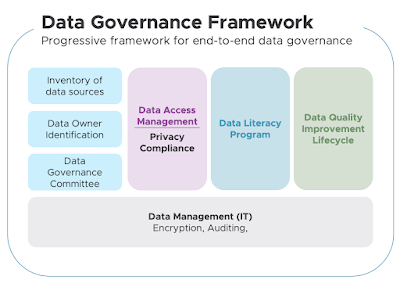We have a basic understanding of the data we have access to, where we could get it, and what we can do with it once we have it, we need to consider how to prevent it from becoming a liability.
Data is more and more likely to rank among a company's most valuable assets.
However, we must never lose sight of the fact that it has two sides to it.
If you handle it appropriately, it will help you get the necessary insights.
However, if you don't handle it respectfully, you may easily cut yourself!
Nearly as many negative effects result from bad data management and planning as there are possible advantages.
They include things like higher expenses and overhead, a decline in consumer confidence, the development of a negative public image about your firm's ethics or environmental impact, as well as very harsh penalties that might put your company out of business.
Here we'll examine the critical elements that must be taken into account to make sure your data policy doesn't put you at odds with your clients, the law, or the line between right and wrong.
We will discuss some of the risks and problems that must be avoided, such as privacy, prejudice, and the effects of AI and technology on the environment.
- Understanding Evolving AI Ethics
- The Significance of "Clean" Data And Bias.
- Keeping Data Within The Bounds Of The Law.
- Implementing Effective Data Governance.
Additionally, we'll examine specific circumstances in which failing to act might result in a violation of our moral and ethical duties to society and our clients.
Find Jai on Twitter | LinkedIn | Instagram
References And Further Reading
- Roff, HM and Moyes, R (2016) Meaningful Human Control, Artificial Intelligence and Autonomous Weapons, Briefing paper prepared for the Informal Meeting of Experts on Lethal Autonomous Weapons Systems, UN Convention on Certain Conventional Weapons, April, article36.org/wp-content/uploads/2016/04/MHC-AI-and-AWS-FINAL.pdf (archived at https://perma.cc/LE7C-TCDV)
- Wakefield, J (2018) The man who was fired by a machine, BBC, 21 June, www.bbc.co.uk/news/technology-44561838 (archived at https://perma.cc/KWD2-XPGR)
- Kande, M and Sönmez, M (2020) Don’t fear AI. It will lead to long-term job growth, WEF, 26 October, www.weforum.org/agenda/2020/10/dont-fear-ai-it-will-lead-to-long-term-job-growth/ (archived at https://perma.cc/LY4N-NCKM)
- The Royal Society (2019) Explainable AI: the basics, November, royalsociety.org/-/media/policy/projects/explainable-ai/AI-and-interpretability-policy-briefing.pdf (archived at https://perma.cc/XXZ9-M27U)
- Hao, K (2019) Training a single AI model can emit as much carbon as five cars in their lifetimes, MIT Technology Review, 6 June, www.technologyreview.com/2019/06/06/239031/training-a-single-ai-model-can-emit-as-much-carbon-as-five-cars-in-their-lifetimes/ (archived at https://perma.cc/AYN9-C8X9)
- Najibi, A (2020) Racial discrimination in face recognition technology, SITN Harvard University, 24 October, sitn.hms.harvard.edu/flash/2020/racial-discrimination-in-face-recognition-technology/ (archived at https://perma.cc/F8TC-RPHW)
- McDonald, H (2019) AI expert calls for end to UK use of ‘racially biased’ algorithms, Guardian, 12 December, www.theguardian.com/technology/2019/dec/12/ai-end-uk-use-racially-biased-algorithms-noel-sharkey (archived at https://perma.cc/WX8L-YEK8)
- Dastin, J (2018) Amazon scraps secret AI recruiting tool that showed bias against women, Reuters, 11 October, www.reuters.com/article/us-amazon-com-jobs-automation-insight-idUSKCN1MK08G (archived at https://perma.cc/WYS6-R7CC)
- Johnson, J (2021) Cyber crime: number of breaches and records exposed 2005–2020, Statista, 3 March, www.statista.com/statistics/273550/data-breaches-recorded-in-the-united-states-by-number-of-breaches-and-records-exposed/ (archived at https://perma.cc/BQ95-2YW2)
- Palmer, D (2021) These new vulnerabilities put millions of IoT devices at risk, so patch now, ZDNet, 13 April, www.zdnet.com/article/these-new-vulnerabilities-millions-of-iot-devives-at-risk-so-patch-now/ (archived at https://perma.cc/RM6B-TSL3)
- Roff, HM and Moyes, R (2016) Meaningful Human Control, Artificial Intelligence and Autonomous Weapons, Briefing paper prepared for the Informal Meeting of Experts on Lethal Autonomous Weapons Systems, UN Convention on Certain Conventional Weapons, April, article36.org/wp-content/uploads/2016/04/MHC-AI-and-AWS-FINAL.pdf (archived at https://perma.cc/LE7C-TCDV)
- Wakefield, J (2018) The man who was fired by a machine, BBC, 21 June, www.bbc.co.uk/news/technology-44561838 (archived at https://perma.cc/KWD2-XPGR)
- Kande, M and Sönmez, M (2020) Don’t fear AI. It will lead to long-term job growth, WEF, 26 October, www.weforum.org/agenda/2020/10/dont-fear-ai-it-will-lead-to-long-term-job-growth/ (archived at https://perma.cc/LY4N-NCKM)
- The Royal Society (2019) Explainable AI: the basics, November, royalsociety.org/-/media/policy/projects/explainable-ai/AI-and-interpretability-policy-briefing.pdf (archived at https://perma.cc/XXZ9-M27U)
- Hao, K (2019) Training a single AI model can emit as much carbon as five cars in their lifetimes, MIT Technology Review, 6 June, www.technologyreview.com/2019/06/06/239031/training-a-single-ai-model-can-emit-as-much-carbon-as-five-cars-in-their-lifetimes/ (archived at https://perma.cc/AYN9-C8X9)
- Najibi, A (2020) Racial discrimination in face recognition technology, SITN Harvard University, 24 October, sitn.hms.harvard.edu/flash/2020/racial-discrimination-in-face-recognition-technology/ (archived at https://perma.cc/F8TC-RPHW)
- McDonald, H (2019) AI expert calls for end to UK use of ‘racially biased’ algorithms, Guardian, 12 December, www.theguardian.com/technology/2019/dec/12/ai-end-uk-use-racially-biased-algorithms-noel-sharkey (archived at https://perma.cc/WX8L-YEK8)
- Dastin, J (2018) Amazon scraps secret AI recruiting tool that showed bias against women, Reuters, 11 October, www.reuters.com/article/us-amazon-com-jobs-automation-insight-idUSKCN1MK08G (archived at https://perma.cc/WYS6-R7CC)
- Johnson, J (2021) Cyber crime: number of breaches and records exposed 2005–2020, Statista, 3 March, www.statista.com/statistics/273550/data-breaches-recorded-in-the-united-states-by-number-of-breaches-and-records-exposed/ (archived at https://perma.cc/BQ95-2YW2)
- Palmer, D (2021) These new vulnerabilities put millions of IoT devices at risk, so patch now, ZDNet, 13 April, www.zdnet.com/article/these-new-vulnerabilities-millions-of-iot-devives-at-risk-so-patch-now/ (archived at https://perma.cc/RM6B-TSL3)





